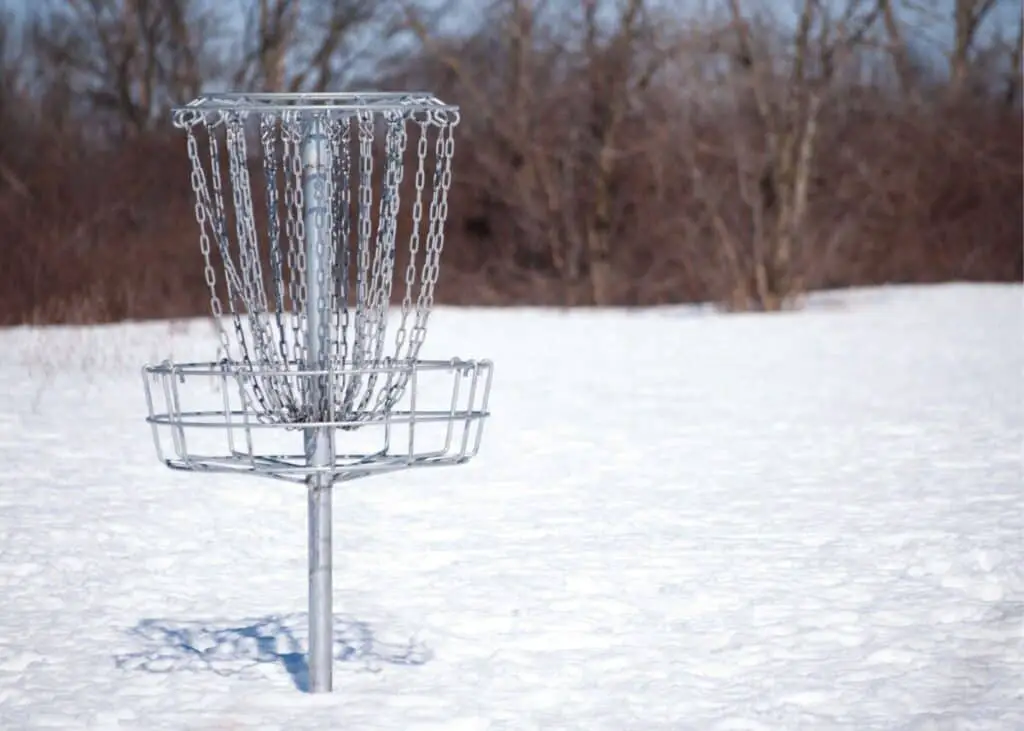When the weather turns cold and the days shorten, most people will put away their disc golf equipment until the spring.
If you truly want to take your game to the next level, you need to stay sharp through the winter. Here are the 13 most important tips to practice disc golf in the winter.
Table of Contents
How To Practice Disc Golf in the Winter
To practice disc golf in the winter, different equipment and strategies should be used to adjust for the cold weather. Discs should be rated for cold weather to keep them from becoming too stiff and brittle. More emphasis should be placed on practicing putting and shorter throws, especially when wearing multiple layers of clothing.
I’ve gathered a list of the 13 most important tips for practicing in the cold winter weather.

1. Use Discs Made For Cold Weather
Because disc golf discs are made from polypropylene plastic, the cold weather can have adverse effects on the disc itself.
Typically, you’ll want a disc golf disc to be pliable and flexible for longer throws. Cold weather can cause the molded plastic of the disc to become stiff and even brittle.
Some players will attempt to keep their discs warm throughout course play, but this isn’t a great strategy because the warmth of the disc will only melt the snow and cause it to refreeze on the disc during play.
Luckily, there are golf discs designed to solve each of these problems when playing in cold winter weather. It’s a good idea to have a set of cold-tolerant discs for practicing in the winter.
Cold-tolerant discs are made from a softer grade plastic than most discs, which allows them to retain flexibility and resist becoming too rigid in the cold.
2. Use a Lighter Disc
Naturally, when playing in colder weather you’re going to be bundled up to keep warm. The advantage? You’re not going to freeze yourself. The downside? Reduced arm speed and limited reach back when making longer throws.
Swap out your heavier discs for a slightly lighter or less stable disc to compensate for the limited arm and torso mobility.
3. Use Bright Colored Discs
This may seem like a no-brainer, but when there is snow on the ground, don’t use a white disc. In the winter there isn’t as much contrast in the landscape, to begin with. So, even if there isn’t snow on the ground, it’s still a good idea to use a lighter-colored disc.
Even if you have a bright-colored disc, there is still the possibility that an errant through will result in a lost disc. In addition to using discs that are brighter than normal, use a set that you won’t mind if they are lost on the course.
4. Ribbon Your Disc
When there is fresh snow on the ground, it’s pretty easy for the disc to hit the ground and instantly become buried in the snow. Even in a couple of inches of fresh powder, this can be an issue when trying to find your disc.
Ribboning a disc is a simple solution to more easily finding a disc that has been thrown in the snow.
All that is required is a colorful piece of ribbon, string, or a streamer that can be attached to the disc. This way, when the disc is thrown and is buried in the snow, the color from the ribbon will show you exactly where the disc is hidden in the snow.
There are several ways to attach the ribbon to the disc. Strong adhesives or duct tape that won’t peel off.
Be sure to make the ribbon long enough so there is always some sticking out from the snow when the disc is buried. Usually, 3-4 feet of ribbon is plenty.
5. Focus on Putting
Winter is the perfect time to practice and perfect your putting form. Longer throws can be limited because of the cold air and restrictions from being bundled up.
So, there’s no better time to get a leg up for the spring than to practice putting in cold weather conditions. The best part about this tip is that you won’t necessarily have to be on the disc golf course to practice putting.
Set up a basket in your garage, basement, or yard to more easily practice putting during the winter. This way there will be no rust to shake off come springtime.
6. Use Cold Weather Disc Golf Gloves
Getting a firm grasp and feel for the disc is essential when throwing a disc accurately. Playing in cold weather can wreak havoc on your grip.
Eventually, your hands are going to all but go numb from the cold, or the disc will be slippery from repeatedly getting buried in the snow or hitting the wet ground.
A great option for overcoming this is a pair of friction gloves. These gloves fit tight like a pair of batting gloves would. So, they aren’t overly bulky either.
Friction gloves will keep your hands warm enough that they won’t eventually go numb, and allow you to grip the disc even when it’s wet.
The only drawback with friction gloves is that some players prefer to remove them when it comes to putting. This is so you can feel the disc in your hands for extra control and accuracy.
7. Bring a Small Bottle of Lotion
You might be wondering what a bottle of lotion has to do with playing disc golf in the winter. But, just as it’s not good to have wet and slippery hands to grip a disc, it’s also not good to have very dry hands either.
In cold weather, your skin will tend to become very dry. When our hands are dry like this, we lose the natural oils and moisture that will allow for a better grip and feel on the disc.
Carrying a little bottle of lotion with you on the course can help when the cold dries out the skin on your hands.
8. Dress in Layers
Rather than wearing large bulky winter gear, it’s better to wear layers of clothing that can easily be taken off if needed. A good rule of thumb is to dress as if it’s 10-20 degrees warmer than the current temperature.
The reason why this is a good rule of thumb is that it will be colder when you first start, but as you start playing and your body warms up, you won’t get too hot under all your clothing.
Start with a base layer that is moisture-wicking material. Avoid cotton fabrics, as they will absorb moisture and sweat. This could end up making you even colder.
Polyester or wool are great options since they provide warmth and resist moisture. You’ll want to stay warm but not wear so many layers that your movement is severely restricted.
9. Take Extra Warm-Up Time
Disc golf isn’t the most physically demanding sport there is, but injuries can still happen in the form of pulled muscles, etc. When it’s cold outside our muscles are cold and tight too.
When practicing disc golf in the winter, be sure to take a little extra time to get your body and muscles warmed up and ready. Small, slow dynamic movements are all that is needed to get ready.
Stretching when your muscles are cold and tight can lead to muscle pulls too. The goal here is to do some basic movements to promote blood flow to our muscles.
This can be as simple as arm circles, arm swings, or trunk twisting. Here are some additional dynamic stretching movements in the video below.
10. Adjust Disc Throws For Cold Weather
The weather, hot or cold will always affect the flight of the disc. Cold weather, in particular, can make the disc perform in ways that you might not have expected.
High, gusting winds, sleet, rain, or very cold air temperature can all change the disc flight after it leaves your hands. For example, cold air is much denser than warm, humid air. It can affect the distance on your throws. 95-degree air temperature is 12 percent less dense than air at 30 degrees.
It might take a hole or two, but you should be able to adjust your game to the weather conditions when practicing in the cold. It’s better to be prepared for this, to begin with.
11. Bring a Towel For Drying Discs
If you have a disc golf bag, it’s a good idea to pack a small towel inside to periodically dry off the disc during the round.
A dry disc will help with the grip and remove any debris or mud that’s accumulated after playing a couple of holes in winter weather conditions.
12. Stay Hydrated
Don’t overlook staying hydrated even when it’s cold outside. Underneath all those layers of clothing, you’re probably going to be sweating some and losing fluids. This perspiration combined with dry air can lead to dehydration.
Our bodies use water to help regulate their body temperature. So, when you’re getting dehydrated in cold weather, your body will become colder much faster.
13. Join a Winter League
Practicing disc golf in the winter doesn’t mean you need to play a solo round after solo round. If you’re in an area that offers a winter disc golf league, it’s a great way to compete with different people and continue to work on your game throughout the cold months.
Don’t worry about being in an ultra-competitive environment either. Most winter disc golf leagues are a way for more competitive players to take it easy and just have fun as they work on their game.
This makes a winter disc golf league a great way to have fun and enjoy the club aspect of playing disc golf even during the winter.
How Cold Is Too Cold For Disc Golf?
It can be too cold for disc golf when the air temperature is 40 degrees and below. Depending on a person’s personal preferences and tolerance to the cold this can vary. Most people should refrain from playing disc golf in weather conditions that are in the low teens or colder. The risks of hypothermia can be very high in these cold temperatures.
There is no hard and fast rule for what constitutes a temperature that is simply too cold for playing disc golf. If you’re hardcore and don’t mind the cold, then by all means go for it.
But, staying safe is key here. It’s probably not going to be a good idea to play a round of disc golf in freezing rain or driving snow with a negative wind chill.
Hypothermia is real and can affect anyone if the conditions are right. If you start feeling confusion, exhaustion, or drowsiness, it’s time to stop immediately and head for the warm car. These can all be signs of hypothermia.
Is Cold Bad For Disc Gold Discs?
The cold air, combined with moisture can damage some polypropylene golf discs. In very cold weather they can become brittle and very stiff which can damage the disc if impacted by another object.
Disc golf manufacturers have created discs that are cold-tolerant, so pick up a set of these cold-tolerant discs for the winter and store the rest for warmer weather.
Summary | How To Practice Disc Golf in the Winter
Playing disc golf in the cold winter weather sounds miserable, but the winter can be a great time to sharpen some of the areas of your game that need improvement before the spring weather rolls in and the competition starts back up.
Playing disc golf in the winter will require a little more planning and gear, but with the right preparation, you will ensure that your rounds are fun and productive, even when it’s cold outside.
